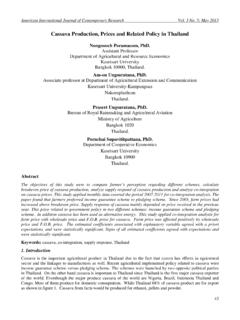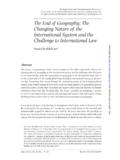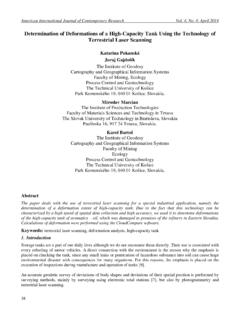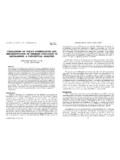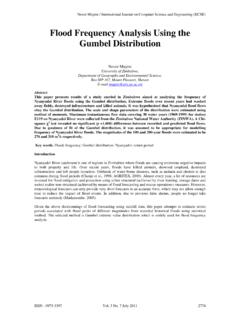Transcription of Introduction to Rural Development
1 1 ENVI-Y001 Introduction to Rural Development 1st semester EMP 2013-14 Prof. Marijke D HAESE, Prof. Johan BASTIAENSEN, Peter MARCHETTI (FDL, Nicaragua) Planning Part 1: Prof. Marijke D HAESE & Prof. Patrick VAN DAMME Part 2: Prof. Johan BASTIAENSEN & Peter MARCHETTI (FDL, Nicaragua) Date Time Lecturer Guest speaker Place 16/11/2013 9 am 12 am Prof. M. D Haese 23/11/2013 9 am 12 am Prof. M. D Haese 25/11/2013 6 pm 9 pm Prof. M. D Haese To be confirmed 6 pm 9 pm Prof. M. D Haese Patrick Van Damme 06/12/2013 6 pm 9 pm Prof. J. Bastiaensen 09/12/2013 6 pm 9 pm Prof. J. Bastiaensen 11/12/2013 6 pm 9 pm Prof. J. Bastiaensen Peter Marchetti 12/12/2013 6 pm 9 pm Prof.
2 J. Bastiaensen Peter Marchetti Part 1: Prof Marijke D HAESE Objectives of the course The objective of this course is to introduce, discuss and frame aspects of Rural Development and to relate these to Rural livelihoods and borrower perspectives of (micro)finance. We start with analyzing the perseverance and determinants of Rural poverty and food insecurity. We discuss the particularities of Rural areas, and discuss issues of Rural poverty with regards to risk, saving and lending. Next we discuss the specificities for (micro)finance of agriculture as the main employer sector in many poor Rural areas. Again particular attention will be on risk and lending.
3 Three sets of key questions will be debated: (1) Why are Rural areas different from urban areas in terms of potential clientele for a microfinance institution? (2) How does poverty relate to risk and finance? Are the poor more risk averse or risk takers? How do the poor react to risk? How do the poor save and borrow? (3) Why are farmers a difficult group to reach for a microfinance institution? Topics covered 1) Introduction to Rural Development Defining Rural Development Rural poverty and food insecurity Rural livelihoods concepts, characteristics, constraints Rural versus urban Development 2) Poverty traps and risk Rural poverty dynamics: Development and policy implications.
4 Transitory and chronic poverty, Rural poverty dynamics, uncovering poverty traps and threshold effects, Development policy implications Poverty and risk Poverty and saving Poverty and lending 3) Agriculture Current trends in the debate on agricultural Development Agriculture and risk Agriculture and need for finance Evaluation Written assignment Readings - Chapters 1 & 2 from Rural Poverty Report (2011) IFAD, Rome - Chapter 3 from the World Development Report (2008) Agriculture for Development , 2007, The World Bank, Washington DC - Barret, (2005) Rural poverty dynamics: Development policy implications. Agricultural Economics, vol 32 (s1): 45-60.
5 - Banerjee, & Duflo, E. (2011) Barefood Hedge-Fund Managers . In: Poor Economics; A radical rethinking of the way to fight global poverty. PublicAffairs, New York, Chapter 6, - Banerjee, & Duflo, E. (2011) The Men from Kabul and the Eunuchs of India: The (Not So) Simple Economics of Lending to the Poor . In: Poor Economics; A radical rethinking of the way to fight global poverty. PublicAffairs, New York, Chapter 7, - Banerjee, & Duflo, E. (2011) Saving Brick by Brick . In: Poor Economics; A radical rethinking of the way to fight global poverty. PublicAffairs, New York, Chapter 8, - Other chapters World Development Report 2008, selected papers from Websites of international organisations (World Bank, IFPRO, IFAD, IMF) International journals including World Development , Journal of Development Economics, Journal of Development Studies, Food Policy, Development Policy Review, Agricultural Economics Part 2: Prof Johan BASTIAENSEN Topics covered 1) Understanding MF for Rural Development in local institutional context Making Rural microfinance work.
6 Transaction costs and social embeddedness Reconceptualizing the impact of financial services as (a contribution to) broader socio-institutional transformation Examples from the FDL: some history of the FDL in recreating and maintaining credit culture in the rather adverse Nicaraguan environment; credit technologies and local social networks; interaction with local institutions: market vs patron-client norms; analysis of the No Pago Movement 2) The Finance Plus approach Concept: finance for Development , link with Rural Development transformation, the need for high quality human capital (beyond merely financial skills) Finance Plus: developmental financial products & complementary non-financial services (illustration of approach & examples from practice) Articulating financial and non-financial services 3) The financial management of an MFI in an evolving context: case-study Fondo de Desarrollo Local in Nicaragua The Microfinance Revolution in the current era of commercialization and Crisis.
7 How to avoid Mission Drift and Betrayal of its lasting contributions? The management challenges of the double bottom line : How to reconcile profitability and Development impact: complementarities and tensions? Evaluation Written assignment. Readings - Bastiaensen, J., P. Marchetti. (2011) Rural microfinance and agricultural value chains: strategies and perspectives of the Fondo de desarollo local in Nicaragua. in The Handbook of microfinance. Ed. B. Almandariz, B., M. Labie. Singapore, World Scientific Publishers, pp. 461-500 - Bastiaensen, J., P. Marchetti. (2011) The Nicaraguan Microfinance Crisis. Between the Scylla of Business for Profit and the Charybdis of Clientelism.
8 IOB Working Paper 2011-04. Antwerpen, Universiteit Antwerpen, IOB, 30 p. - Bastiaensen, J. & P. Marchetti. (2007) A critical review of CGAP-IADB policies inspired by the Fondo de Desarrollo Local, Nicaragua in Enterprise Developmant and Microfinance. London, Practical Action Publishers, Vol. 18, n 2/3, June/September, pp. 143-157. - Bastiaensen, J., T. De Herdt & B. D Exelle. (2005) Poverty Reduction as local institutional process in World Development . Special Issue Exploring the politics of poverty reduction: how are the poor represented? London, Elsevier Science Ltd, vol. 33, n 6, pp. 979-993. - Bastiaensen, J, D'Exelle B. (2002) -To Pay or Not to Pay?
9 Local Institutional Differences and the Viability of Rural Credit in Nicaragua. In: Journal of Microfinance. Provo, Marriot School of Management, Brigham Young University, vol. 4, no. 2, Fall, p. 31-56.



